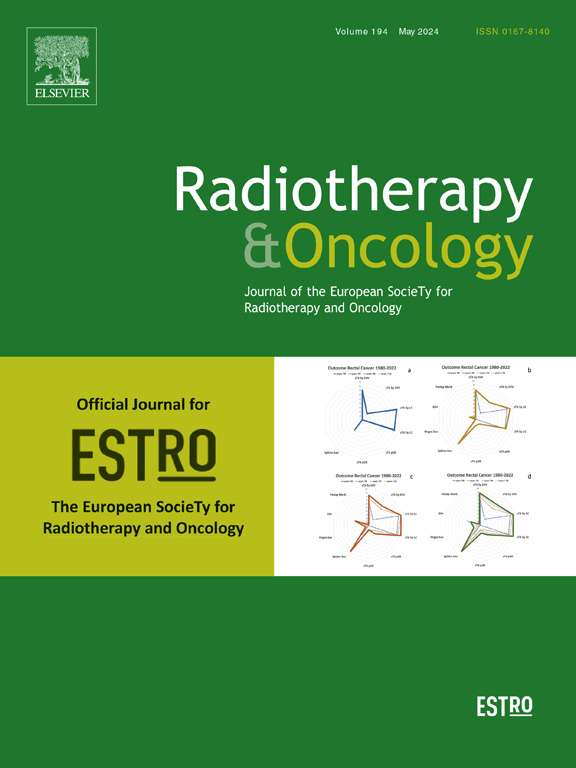Standardized anesthetic protocol in pediatric Radiotherapy: A retrospective analysis of clinical efficacy and outcomes
IF 4.9
1区 医学
Q1 ONCOLOGY
引用次数: 0
Abstract
Background and purpose
Radiotherapy plays a critical role in the treatment of pediatric cancers; however, the need for absolute immobilization during treatment necessitates the use of general anesthesia or deep sedation.
Materials and methods
In this retrospective observational study conducted at Salerno University Hospital between 2022 and 2024, we evaluated a standardized anesthetic protocol based on the exclusive use of a laryngeal mask airway (LMA) in pediatric patients undergoing radiotherapy. Data were collected from 420 anesthesia sessions performed in 22 patients under 14 years of age with solid or hematological tumors. The protocol involved premedication with midazolam when indicated, induction with either intravenous propofol (administered in 77.3 % of sessions with a mean dose of 1.64 mg/kg) or inhalational sevoflurane (in 22.7 % of sessions), and maintenance with sevoflurane at a mean minimum alveolar concentration of 2.2. Continuous monitoring of vital parameters was ensured via advanced remote systems, while airway management was successfully maintained with LMA in all sessions.
Results
The overall complication rate was low (1.9%), with laryngospasm (0.95%), postoperative delirium (0.71%), and a single episode of tachycardia/hypotension (0.24%) observed; importantly, no major adverse events occurred. The median time to awakening was 3 min, and full recovery in the post-anesthesia care unit was achieved within 35 min.
Conclusion
These findings suggest that the standardized anesthetic protocol is both safe and effective, ensuring rapid recovery and minimal complications, thereby optimizing the management of pediatric radiotherapy sessions.
标准化麻醉方案在儿科放疗:回顾性分析临床疗效和结果。
背景与目的:放射治疗在儿童癌症的治疗中起着至关重要的作用;然而,在治疗过程中需要绝对固定,需要使用全身麻醉或深度镇静。材料和方法:在这项于2022年至2024年在Salerno大学医院进行的回顾性观察性研究中,我们评估了一种标准化的麻醉方案,该方案基于喉罩气道(LMA)在接受放疗的儿科患者中的独家使用。数据来自22例年龄在14岁以下 的实体或血液肿瘤患者的420次麻醉。该方案包括在有指诊时预先使用咪达唑仑,静脉注射异丙酚(77.3% %的疗程使用,平均剂量为1.64 mg/kg)或吸入七氟醚(22.7% %的疗程)诱导,七氟醚维持在平均最低肺泡浓度为2.2。通过先进的远程系统确保持续监测重要参数,同时在所有会话中成功地使用LMA维持气道管理。结果:总并发症发生率低(1.9%),喉痉挛(0.95%)、术后谵妄(0.71%)、单次心动过速/低血压(0.24%);重要的是,没有发生重大不良事件。苏醒的中位时间为3 min,麻醉后护理单元的完全恢复时间为35 min。结论:标准化麻醉方案安全有效,可确保快速恢复和最小并发症,从而优化儿科放疗的管理。
本文章由计算机程序翻译,如有差异,请以英文原文为准。
求助全文
约1分钟内获得全文
求助全文
来源期刊

Radiotherapy and Oncology
医学-核医学
CiteScore
10.30
自引率
10.50%
发文量
2445
审稿时长
45 days
期刊介绍:
Radiotherapy and Oncology publishes papers describing original research as well as review articles. It covers areas of interest relating to radiation oncology. This includes: clinical radiotherapy, combined modality treatment, translational studies, epidemiological outcomes, imaging, dosimetry, and radiation therapy planning, experimental work in radiobiology, chemobiology, hyperthermia and tumour biology, as well as data science in radiation oncology and physics aspects relevant to oncology.Papers on more general aspects of interest to the radiation oncologist including chemotherapy, surgery and immunology are also published.
 求助内容:
求助内容: 应助结果提醒方式:
应助结果提醒方式:


